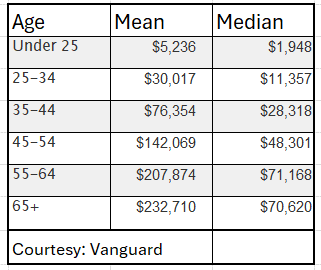We’re all told to begin stashing away as much as we can in our 401k, IRAs, and Roth IRAs at an early age. Sadly, most of us don’t. The median retirement account balance is minuscule for Americans during their first two decades of working and falls far short of anyone maxing out the contribution limits (or even meeting any employer match). Too bad for them! This article is for the lucky ones who have accumulated a nice nest egg by 45.

Less Ideal: The 401K Loan
Most readers might think we are discussing the 401k loan trick. To be fair, borrowing against your 401k is a reasonable option. You can take a loan penalty-free and tax-free from your pre-tax 401k, as long as you “pay yourself back with interest,” as they say.
That point of paying yourself back with interest is entirely confusing to almost everyone and even the so-called financial experts tend to get it wrong. Yes, you have to pay back what you borrowed, but that’s just taking the money you got up front and putting it back in later. No harm done. You didn’t have to pay taxes or penalties on the lump sum you took out, so it’s only fair that you use post-tax dollars to pay it back later.
The interest is the weird part. Who gets the interest, your employer, your fellow employees in the plan, the IRS, or someone else? Turns out all of those are wrong. You get the interest! What?!? Yes, you actually pay the interest and it increases the balance of your account. However, that increased balance is still considered pre-tax dollars much later on in life when you are finally required to withdraw the old-fashioned way at age 70+.
There are other disadvantages: the loan duration is only 5 years (not the 30 you might want when buying investment or personal property). You also can’t contribute new funds into the 401k while the loan is outstanding (although weird loopholes may apply if you have multiple jobs or already changed jobs, or have your own self-employed 401k).
You don’t get any sort of tax deduction on what you pay back, otherwise you’d be getting a tax deduction twice. If that sounds confusing, don’t even worry about it. It’s not important – just know that the 401k loan is a very reasonable way to tap your retirement account at a very low interest rate, but has limitations.
Very Limited: The First Time Homebuyer
Most people have heard about a penalty-free withdraw for first time homebuyers, but the limit is so low in this day and age that it’s barely worth mentioning. You can take up to $10K out of any IRA without penalty, but you must still pay the tax. In most parts of the country, that isn’t going to make much of a dent in the down payment. Perhaps if they indexed this to inflation it would help a little, but it’s one of those laws that came out over a decade ago that no one seems inclined to fix. Next.
Best Retirement Account Early Withdrawal Method: SEPP Withdrawal
For those who want to tap a large retirement account before age 59.5, there is the little known and totally legal method called SEPP Withdrawals. SEPP stands for Substantially Equal Periodic Payments, and it is a strange IRS loophole created for savers who claim they are retiring early. It’s also know as 72(t) payments, because it is codified in section 72(t) of the complex IRS rules governing retirement accounts.
You can start at almost any age earlier than the usual 59.5, and there would be no point to starting later because you can withdraw penalty-free the regular way.
Why is the SEPP method better than the others?
1.) There is no arbitrarily low dollar cap on the amount you can take. If you have a multi-million dollar balance (or in Peter Thiel’s case over a billion), then you can drain it all over the withdrawal period.
2.) It counts as income in case you want to qualify for a loan or condo / co-op purchase. Early retirees or those with lots of savings but difficult-to-document income can use these withdrawals as an income source for any situation that requires income but not assets.
3.) You can decide how much to take. You don’t have to drain all of it and you can basically stop once you are 59.5 or after 5 years, whichever is later.
4.) There is no 10% early withdrawal penalty.
What’s the catch? You are still limited to how much you can take in any given year. It is approximately 1/30th of the amount in your retirement account per year (even less if you opt in when extremely young, say 35-45). That’s because the rules require you to simulate a retirement that begins the day you withdraw, in lieu of the normal 60-70 age range.
Still, of all the possible methods, this is the least used and most beneficial way to tap into a large retirement account. Best of all, the tax is staggered throughout many years, so hopefully you can optimize further by engineering a lower tax bracket during your years of withdraw. Contrast this with the much-loved backdoor Roth IRA conversion — also an interesting technique — but one that leaves you with a huge lump sum tax bill the year you do it.
Btw, nothing stops you from taking some of these SEPP payments and spinning up a new Roth IRA or Roth 401k, a topic for next time…
The Main Downside to Every Early Withdraw
What’s the main downside to any of these methods? Opportunity Cost. For the past century, buy-and-hold as worked very well over any long period, and when you withdraw that money, you are likely doing so because you want to spend it. Are you willing to give up the age-old long term stock market return of 8%?
It’s important to call out a particular group that might be hoping to withdraw early: investors who want to beat the market using alternative asset classes. Do you think your real estate, startup angel investing, crypto speculation, or futures and options trading has a chance of beating the market? You might be considering taking money out of the safe and regulated world of retirement accounts to take an increased gamble. Please don’t. Very very few people can beat the market long term, and those that do aren’t the ones who need to tap their 401k’s for cash.
Mr. "Hud" Chavij recently came from abroad and brought with him a level of determination and creativity that instantly gained him a reputation among the NYC real estate thought leaders.


